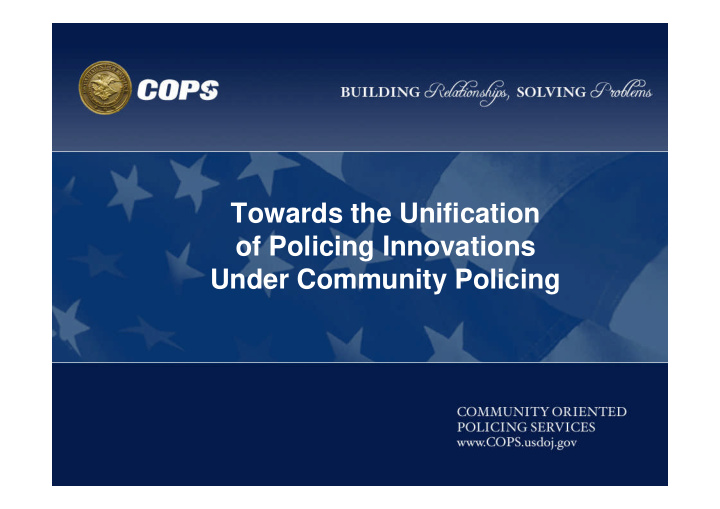



Towards the Unification of Policing Innovations Under Community Policing
Community Policing in the 1980s, becomes more prevalent starting in the mid-1990s; More than $13 billion investment to more than 13,000 agencies COPS focus on problem-solving and specific goals aligned to community issues
Community policing is a philosophy that promotes organizational strategies, which support the systematic use of partnerships and problem solving techniques, to proactively address the immediate conditions that give rise to public safety issues, such as crime, social disorder, and fear of crime. 3 Office of Community Oriented Policing Services ▪ www.cops.usdoj.gov
Community Partnerships Collaborative partnerships is about building relationships to develop solutions to problems and increase trust in police. Other Government Agencies Community Members/Groups Non-Profits / Service Providers Private Businesses Media
Reconnecting policing to citizens to encourage proactive, collaborative and strategic approaches to crime prevention Police rarely solve public safety problems alone Trust needed for citizen participation 5 Office of Community Oriented Policing Services 10/18/2010 www.cops.usdoj.gov
Organizational Transformation The alignment of organizational management, structure, personnel and information systems to support community partnerships and proactive problem solving efforts. Agency Management Climate and culture Leadership Labor relations Decision-making Strategic planning Policies Organizational evaluations Transparency Organizational Structure Geographic assignment of officers Despecialization Resources and finances Personnel Recruitment, hiring and selection Personnel supervision/evaluations Training Information Systems (Technology) Communication/access to data Quality and accuracy of data
Problem Solving Engaging in the proactive identification and examination of problems to develop effective responses that are rigorously evaluated. Scanning: Identifying and prioritizing problems Analysis: Analyzing problems Response: Responding to problems Assessment: Assessing problem solving initiatives Using the Crime Triangle to focus on immediate conditions (Victim/Offender/Location)
Community Policing Umbrella
Problem-Oriented Policing Broken Windows Compstat Third-Party Policing Hot Spots Intelligence-Led Policing Predictive Policing Evidence-Based Policing Values Based Policing
Strategy Focus Objective Rationale Methods Community -Crime -Proactive Public support is -Building -Quality of life Policing - critical for police Relationships -Building Trust Prevention effectiveness -Solving -Trust Problems Traditional - Violent Crime Reduction Increase -Routine Patrol Policing -Prop. Crime of crime enforcement and -Rapid -Traffic visibility response - Arrest Problem- Specific, Address Prevention more SARA Oriented recurring the root effective than Policing problems causes enforcement Broken Deteriorating Improve Reducing signs of - Policing incivilities; informal social social disorder will Neighborhoods -Order Windows Control increase social maintenance; control/decrease -Neighborhood 10 crime empowerment Office of Community Oriented Policing Services 10/18/2010 www.cops.usdoj.gov
Strategy Focus Objective Rationale Method Intell Cycle: Intelligence -Terrorism Improve Action only -Planning Led Policing -Violent collection, effective when -Gathering Crime analysis, and based on solid -Processing/Eval sharing of information -Analysis -Share info to inform -Reevaluation decisions Compstat -Short-term Increase Reduce crime Identify -Geographic accountability by increasing persistent -Patterns and timely accountability problems at data routine accountability meetings Third-Party Public safety Involve third Police cannot Collaboration, problems where solve problems 11 Policing parties in Persuasion ID parties beyond alone solutions police are accountable Office of Community Oriented Policing Services 10/18/2010 www.cops.usdoj.gov
Strategy Focus Objective Rationale Method Hot Spots Serious crime in Reduce serious Less hot spots, less Increase patrol geographic area offences in high crime and enforcement crime areas through resource deployment Predictive Integrating crime Predictive To prevent and Better integration analysis, prevention respond to crime of information to Policing technology strategy and more effectively inform resource tactics allocation Ethical behavior, Increase trust and Ethical behavior is Emphasis on “Can I Values Based the cornerstone of do this?” to “Should Quality decision- confidence in the Policing public trust I do this? ” making, character police Evidence- Testing police Improve police Police practice Research 12 strategies practices to reduce should be based Assessment Based crime on scientific Evaluation evidence of what Office of Community Oriented Policing Services 10/18/2010 www.cops.usdoj.gov works
Compatibility with community policing philosophy Innovations have a narrow focus on a specific aspect of police business Value added if developed in concert with existing philosophies rather than as a stand alone or in isolation Community Policing philosophy is broader, can use routine patrol for problem identification, outreach, police visibility, reduce fear of crime Effective policing requires collaboration 13 Office of Community Oriented Policing Services 10/18/2010 www.cops.usdoj.gov
“A collaborative law enforcement approach combining problem-solving policing, information sharing, and police accountability, with enhanced intelligence operations.”
ILP is executive implementation of the intelligence cycle to support proactive decision making for resource allocation and crime prevention. In order to successfully implement this business process, police executives must have clearly defined priorities as part of their policing strategy.”
Partnerships lead to: • Better information upon which analysis can be based • Crime/Terrorism Prevention and Reduction Strategies • Improved sharing of information and intelligence to solve problems 16 Office of Community Oriented Policing Services 10/18/2010 www.cops.usdoj.gov
COPS Hiring 4-year problem-solving grants Predictive Policing plans to develop, test, implement and evaluate a predictive policing model Smart Policing data-driven, evidence-based policing by encouraging state and local law enforcement agencies to develop effective, efficient, economical Building Communities of Trust focuses on developing relationships of trust between law enforcement, fusion centers, and the communities they serve, particularly immigrant and minority communities, so challenges of crime control and prevention of terrorism can be addressed Herman Goldstein Awards achieved measurable success in resolving recurring specific crime, disorder or public safety problems faced by police and the community Homeland Security Advisory Committee Using community policing approach to counter violent extremism Teaching Police Departments/Laboratories 17 Office of Community Oriented Policing Services 10/18/2010 www.cops.usdoj.gov
Questions? 18 Office of Community Oriented Policing Services 10/18/2010 www.cops.usdoj.gov
Recommend
More recommend